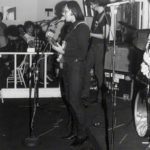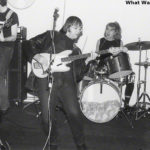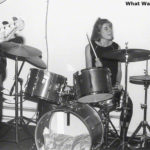Several years back when the idea of creating something out of what I had accumulated crossed my mind, I agonized over how to go about presenting it. In fact, I agonized so much that it turned into the proverbial monkey on my back. Should I put up video? What about sound? How can I arrange the news clippings? The only thing that was fixed were what bands I felt were important to highlight. Through the years, that focus turned into who the members were that were in these bands. Figuring that they would be able to tell their story much better than I could. This idea morphed into the blog you are now reading.
When it came time to speak to former band members, Peter Stuart was at the top of my list. Not only for the fact that he was an astounding bass player but also for the fact that The Tryfles led to yet another beloved NYC garage-punk band, The Headless Horsemen. With Peter’s involvement in both, it’s not rocket science to guess who played a key role in driving both these well-loved bands.
With that in mind, I found myself at vintage guitar headquarters Retrofret on a recent weekday evening to have a chat with the maestro himself. This portion of the interview will center on the beginnings of the penultimate NY garage band, The Tryfles, and eventually work its way through the creation of The Headless Horsemen.
SSA: Peter! Let’s start at the very beginning.

Peter Stuart: Sounds good to me! I’ll start the whole Tryfles thing by saying that John Fay’s ambition for The Tryfles was that we make a record that’d be worth a lot of money someday. This was John’s stated mission. So, while I don’t know what The Tryfles 45 is worth nowadays, it’s certainly worth more than the $3 that it cost us when it was made!
SSA: Can you touch on how each of you guys met? I know you were friends with future Fuzztone and Headless Horseman Elan Portnoy since high school.
PS: John Fay and I were the basic nucleus of the group. Ellen O’Neill and Lesya Karpilov were both friends of mine that I sucked into the band afterward. As far as groups go, The Tryfles were very much a designed band. Much in the way the Byrds were. In fact, Roger McGuinn is my hero because he designed, or, I should say, he “picked” people. He didn’t intentionally select great musicians: He’d say, “Oh, that’s an interesting person,” or, “I just met this guy on the beach. He has a Beatles haircut, and he plays the bongos: He’s my drummer.” He’d put together a band of personalities, not a band of musicians. And The Tryfles were absolutely a band of personalities. It was intentionally set up that way.
Initially, I was friends with Ellen’s brother and sister who I had both met in the late 70s. Oddly enough, at a high school gig where one of my bands played. In fact, not only did they all go to school there, their mother even taught there! Through family connections, I met Ellen, and we began hanging out in the early 80s. She’d been kind of a teenage hanger-on throughout the late, late 70s rock scene. By the time I met her, she was attending college but still heavily into music. We would often end up going to gigs together. Not as boyfriend or girlfriend but more like good pals. We built our friendship on this.
John was going to high school at the time. I forgot where he went, but he went to one of those quirky private schools. He’d been in the early version of The Outta Place with Orin Portnoy, and I think Shari Mirojnik. He, Orin and Shari had a band called The Disturbed.
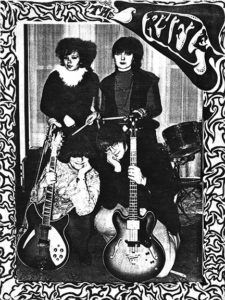
SSA: Was this around 1982?
PS: Yeah, around that time. Elan Portnoy was the one who first introduced me to John Fay. In fact, Jordan Tarlow, Elan and John all went to the same high school. As you noted, I had already been friends with Elan for years. In fact, we’d played in a couple of bands together. Once Elan introduced me to John, we hit it off right away.
SSA: The meeting of two like minds. What were you doing musically around that time?
PS: At the time I was playing in blues bands. It’s funny because while I’d get them to do some stuff that I like, I had to play endless Muddy Waters jams. Now, I love Muddy Waters, but I really don’t like white kids playing Muddy Waters songs unless they’re really good at it. And these people weren’t really good at it!
SSA: That’s pretty funny. So, while you were active musically, you still weren’t doing the music you liked. Why the inertia?

PS: You know when you get into a lull in life? Well, that was where I was at that moment. I’d been in a band in 1979, 80 that looked like we were going to get signed. We had a publishing contract and everything. And, as the way it often does, the whole thing was torpedoed by our guitar player, my best friend, who just balked and quit.
So, instead of being in this signed band making records, I was working at a record store. I was in this miserable fat period of life, just buying bass guitars and feeling sorry for myself. And I couldn’t seem to meet anybody who wanted to do what I wanted to do, which was play 60s rock ‘n’ roll.
That was when Elan happened to bring John to my record store. He and I started to talk about records and how we both owned a Danelectro bass. We immediately bonded.
SSA: That was the connection.
PS: That was the connection. We start talking, and I found out he was into doing the same thing I wanted to do. And, god, I must have been 22 or 23, and he was around 17. John was actually going to graduate high school in the summer of 1984. His family was then planning to move to Seattle.
One day I convinced him to guest in a silly 60s frat rock band I was playing in called Life of Leisure. He came up, did a couple songs, and it was the best we ever sounded. So, after that show both of us had the same idea: “Screw these guys. Let’s start our own band.”

Around the same time, John kind of got kicked out of The Outta Place. More accurately, they had reformed without him. You know, I love John like a brother, but he was not the easiest guy to get along with sometimes back then. I know Orin was also not the easiest guy to get along with either. My impression was that there was a bit of friction there.
[John Fay later elucidated a bit on this period: “Unfortunately, I didn’t have a lot of ‘street smarts’ and Orin and Sherri did, which I think was necessary. Additionally, I also had to deal with control freak parents that wouldn’t allow me to play out—it might have been the first gig but the band didn’t have Andrea Kusten or Mike Chandler yet . . . So that spelled the end of that. This is where I think the friction mainly lay.”]
As luck would have it, right when he and I start hanging out, The Outta Place started playing at the Dive. One day John tells me, “Hey, this band I used to play in is playing at the Dive. Ya wanna go?” While this sounded intriguing, my initial reply was “So, what’s the Dive?” This was how we first saw The Outta Place with, I believe, The Mad Violets on the same bill. That first visit to the Dive happened in October or November 1983. Unfortunately, I can’t remember the exact date. But, I do remember that, as soon as John and I walked in, we were immediately transfixed. Both of us thought, “This is kind of cool.”
SSA: Getting back to Ellen, how did she get involved?

PS: So, after John and I hooked up, I introduced him to Ellen. The three of us went to see a screening of The Monkees’ Head at her college. John and Ellen immediately hit it off. At that point, she was just getting into playing drums. In fact, I actually helped her buy a drum kit. I remember riding out to Queens on the subway with her on the day she bought a beautiful Rogers kit from this cranky old guy who lived in a basement full of drums. Unfortunately, she had no clue how to play it! But, I’ll give her this: She sat down, and within six or eight weeks, she could keep a beat enough to back a band.
By this time, John and I had already had our first rehearsal of what was to become The Tryfles with my drummer friend Richard Matthews. Now, Richard was a Keith Moon fanatic that thought there were only two drummers worth listening to in the world. Keith Moon and Elvin Jones. So, you have Richard, and then you have John, who is a really, really good, tight rhythm guitarist. Then you had me, stuck in the middle. Needless to say, it just didn’t work.
I told John that I had a friend who’s just starting to play drums and was really eager to be in a band. No frills, just basic stuff. The next time we went to the studio we invited Ellen. And lo and behold, it actually started to sound like something.
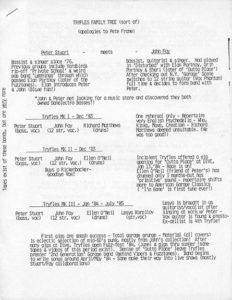
[At this point Peter hands me a few mimeographed sheets labeled “Tryfles Family Tree.”]
And here is The Tryfles Family Tree. It was made sometime in 1986 for a fanzine, whose name escapes me. It perfectly charts where we were at that time. Can’t ask for more than that, can ya?
We did only one rehearsal with Richard’s Keith Moon-style drumming. Which, if we were better, might have worked. However, Richard was also a difficult person as well. So, we ended up making the right decision. With three intense male personalities, the band would have been doomed from the get-go.
When Ellen sat down and started drumming—”Boom, bang, boom, bang, boom, bang”—she was perfect. Her strong desire to be in a band enabled her to succeed where technically better drummers couldn’t.
Nevertheless, we still sounded thin. That’s what made me think of Lesya Karpilov, who I worked with at the record store. Now Lesya is really, really brilliant, a bit wacky and the most intense personality that I had ever met. I totally fell for her the second I met her. My first impression was that this girl is a rock star. Her whole persona was just so spot on. Ironically, I ended up having to convince her to join.
Now, keep in mind that this is a high school girl of 16, who had already stopped attending high school and was working in a record store. There was nothing that could phase her. She already had this persona.

SSA: What was her persona? Tough girl?
PS: It was this whole cooler-than-anyone rock chick. Chrissie Hynde was her role model. The whole eye makeup and hair thing. At the store, both of us would sit behind the counter and sing along to records. I was pleasantly surprised to find out she really had a good voice!
Thinking about our band situation, I approached John and Ellen and told them about this girl who I work with who I think would really make this band. Immediately Ellen said, “I don’t want to be in a band with another girl,” and John said, “I don’t want to be in a band with another guitar player.” I basically told them that we’re were going to try this anyway.
So, Lesya comes in, and she and Ellen hate each other instantly, and she and John hate each other instantly. But in an odd way, they all realized that BANG! The Monkees. Two girls, two guys. The look was perfect, and it sounded like something as soon as we started playing. It was just one of those times when everything jelled. We were rough as shit…but it worked.
SSA: Thus, The Tryfles were born. Was this around the time of the Dive video that Anthony “Tony G” Gliozzo shot? I seem to remember you telling me this was the second live gig by the band.

PS: Yes, in fact, in that video you linked to on your site, you’ll notice that the sound is a bit strange. It’s almost like you can’t tell that it’s “He’s Waiting” by The Sonics. The reason for that is, between the time we rehearsed and the time we got onstage, we somehow were not in the same key! I’m playing in F, and the rest of the band is playing it in E. It’s the most discordant thing musically possible.
In many ways, it’s apropos that The Tryfles are immortalized this way. If this isn’t a Tryfles moment, I don’t know what is. Four people up there playing their hearts out…in different keys.
Stay tuned for Part II! Extra special thanks to Peter Stuart for his time and ephemera and West Coast operative Greg Gutbezahl for his photos. Visit Greg’s photo site here!




